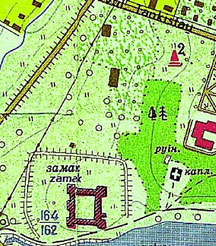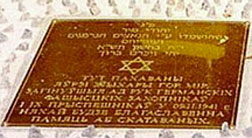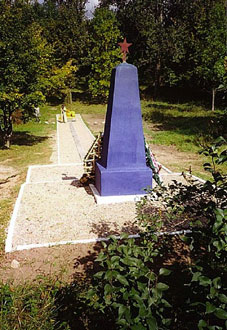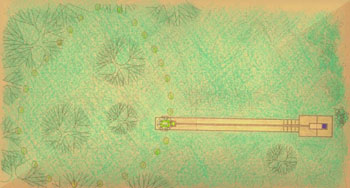Mir Memorial
by Zvi Reshef - Architect
| In November 2000,
UNESCO decided to put the Mir Castle and its surroundings
on the list of World Heritage Sites. Certainly this site
is of prime significance to Belarus national and cultural
heritage. |
|
The beginning and the end of the Jewish community in the
town of Mir are firmly bound to the Castle. Looking for new
trade avenues, the Feudal Prince who resided there, invited
the first Jews to Mir in the 17th century. A thriving community
of 3,000 Jews grew with a diverse culture and a Yeshiva that
became one of the most important centers of Jewish scholarship
in the world.
The Germans imprisoned the last Jews
of the town in the Castle. On the 13th of August, 1942
the remaining Jews of Mir were murdered.
The largest of the four extermination sites in Mir is located
close to the Castle. 1600 Jews were massacred there on the
9th of November, 1941.
|
.jpg) |
 |
After liberation, the Soviets marked
the site with an obelisk made of concrete, as they did
elsewhere. The standard inscription on the obelisk tells
about "innocent victims of fascism" with
no mention of Jews.
The map shows the castle on the lower
left and the site on the top right. The site is marked
by an icon of an obelisk and a digit "2".
|
After
the breakup of the USSR, Jews started to visit Mir. Visitors
from the US installed, at the foot of the obelisk, a tombstone
in memorial of Rabbi Avraham Zvi Kamai, the last Rabbi
of Mir. The few survivors of the Holocaust, members of the
Mir Jews Organization (Irgun Yotsai Mir) from Israel added
a plaque to the obelisk.
|
The survivors decided
to install a new memorial in the spring of 1998. The
memorial was finished for the 13th of August annual memorial
ceremony.
|
Present at the ceremony were the Minister
of Culture of Belarus, the Israeli ambassador, the president
of the United Jewish Communities in Belarus, the Mayor
of the town, a group of Jewish Mirers from all continents,
representatives of Scotland Yard, a group of Jewish youth from
Minsk and a group of local children and adults. The event was
covered by WNT and by the local press. |
|
With the new installation, all the memorial objects that
existed were kept, except for the obelisk that was painted
blue and the plaque that was replaced by a new one in a new
location nearby.

Here were buried
Jews of Mir
who were exterminated by the German Nazis
and their collaborators
18th of Heshvan 5071
(November 9th 1941)
|
 |
| The site now exhibits
collective Jewish and universal commemorative symbols: a
circle of crude fieldstone, a mound of stones (the ruins),
a tree, rock shreds, a ceremonial path, a tombstone, and
an obelisk. |
 |
There are two focal points on the site:
the obelisk - vertical and universal, and the ruins - horizontal
and Jewish. They are arranged in an axial form and joined via "The
Path of Pain" that proceeds by an imaginary line and links
to the Castle. |
| People who arrive
from the Castle to the obelisk view the site and follow the
footsteps of the victims down to the Pit. They may touch
the pointed rock shreds along the Path of Pain and arrive
at a memorial plaque and the Ruins at the lowest level. Out
of the yellow shattered mound, piercing into the circle of
crude field stones grows the Tree of Survival and Hope. |
The path is narrow,
since the experience and perception of the place need to
be personal, leaving each individual to contemplate their
own thoughts. There is a contrast between formality and informality;
the blue solid obelisk and the yellow fragmented ruins that
allows individual degrees of freedom and personal interpretation
in the process of remembrance. |
|
Zvi Reshef, an Israeli and the architect of this new memorial noted:
On the Memorial Day of the Holocaust
my late mother, who lost almost all of her family, used
to tell me that the great loss for her is the destruction
of the Jewish culture and civilization." The people
are gone and others are born" she used to say "but the warm
Jewish home, the colorful life and vitality of the Shtetl were ruined." This
is the perception that I inherited.
|
Updated
March 2005
|